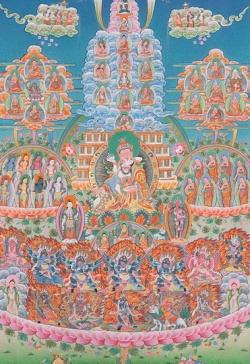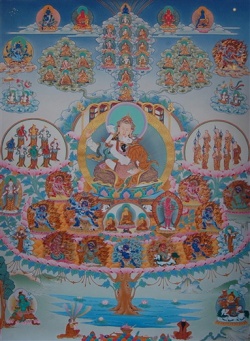The Refuge Tree
In Tibetan Buddhism, the Refuge Tree, (alternate English renderings: Refuge Field, Merit Field, Field of Merit: 'field' is a rendering of the Sanskrit "kshetra"), may be represented on a thangka as a mnemonic device and precursor to being fully visualized by the sadhaka during advanced Refuge Formula or evocation, the lineage of gurus and transmission of teachings is depicted in visual form as a visual mind map. Refuge tree and merit fields, as mandala, are Pure lands.
Each denomination or sect, and even each lineage or disciplic succession or parampara has a "genealogical" chart that has come to be rendered into English under a number of names, principally Refuge Tree or Refuge Field. In this Refuge Tree are represented the founders and teachers in a tree diagram or fractal arrangement that symbolizes the interconnectedness of the various groups and constituents and as it takes a branching form is iconic of a tree and growth patterning.
Each denomination, and even each lineage has a "geneological" chart that is known as the Refuge Tree. In it are represented the founders and teachers in an arrangement that symbolizes the interconnectedness of the various groups.
As the Dalai Lama explains:
"Within the context of Tibetan Buddhism, the importance of lineage extends far beyond the ordinary sense of a particular line of inheritance or descent. Lineage is a sacred trust through which the integrity of Buddha's teachings is preserved intact as it is transmitted from one generation to the next. The vital link through which the spiritual tradition is nourished and maintained is the profound connection between an enlightened master and perfectly devoted disciple. The master-disciple relationship is considered extremely sacred by all the major schools of Tibetan Buddhism."
Practitioners use the Refuge Tree and /or a Field of Merit to visualize their lineage and chain of devotion, of merit and of obligation and protection.
It is depicted as a wondrous tree with several branches. By means of artistic convention, even the branches at the back of the tree are indicated. In the sky overhead with the sun and the moon is usually found the samboghakaya form of the founding buddha, and the bodhisattvas and dakinis associated with the lineage. On the upper branches are the founding human members and closer to the ground, we see the 20th-century masters. Living teachers are not depicted.
At the foot of the great tree are the dharma protectors and the various kinds of offerings. At the bottom of the scroll or poster are often representations of those who are taking refuge in the particular tree. Practitioners can imagine themselves there, and also, they can imagine a forest of similar trees belonging to the other lineages knowing that the Buddha, Shakyamuni, appears above all of them.
Similar in function to a Refuge Tree is what is known as the Field of Merit.
Merit Field
The Field of Merit (Tibetan: ཚོགས་ཞིང་།, Wylie: tshogs zhing) is a pictorial representation in tree form of the "three jewels" (skt. triratna) and the lama (skt. guru), employed in Tibetan Buddhism as an object of veneration when taking refuge. Each school or sect has its own distinctive form of the tree in which the numerous lineage-holders or vidyadhara and dharma protectors or dharmapāla are represented.
In discussing the visualisation of the Merit Field, Namkhai Norbu (2001: p.103) links the Three Jewels of Buddha, Dharma and Sangha with the Three Roots of Guru, Deva and Dakini:
The merit field (tshogs zhing, that is the source of all the accumulation of merit, designates the manifestation of the Three Jewels (Buddha, Dharma, Sangha) and of the Three Roots (Guru, Deva, Dakini) visualised by the practitioner.
Santina (1997: p.227) states that:
In the Buddhist tradition...the tree is an important archetypal symbol. Specifically, the refuge tree may be identified with the pipal or bodhi tree.
The 14th Dalai Lama, in the foreword to Karmapa: The Sacred Prophecy states:
Within the context of Tibetan Buddhism, the importance of lineage extends far beyond the ordinary sense of a particular line of inheritance or descent. Lineage is a sacred trust through which the integrity of Buddha's teachings is preserved intact as it is transmitted from one generation to the next. The vital link through which the spiritual tradition is nourished and maintained is the profound connection between an enlightened master and perfectly devoted disciple. The master-disciple relationship is considered extremely sacred by all the major schools of Tibetan Buddhism.
When Guru Rinpoche is at the center surrounded by deities and lamas, it can be a Konchok Chi Du tree. Konchok Chi Du is the name of a cycle of tantric practices that centres on Guru Rinpoche as the embodiment of the three jewels and roots. Its origin is a complete cycle of terma of Jetsun Nyingpo's and is one of the Northern Treasures of the Nyingma.
Konchok means "Supremely Rare" and when part of the expression Konchok Sum, it means The Three Jewels (Buddha, Dharma, and Sangha; and by extension, the Three Roots: Lama, Yidam, Protector.)

